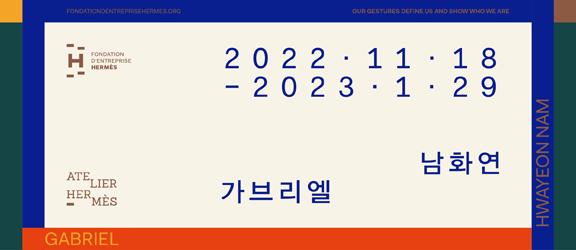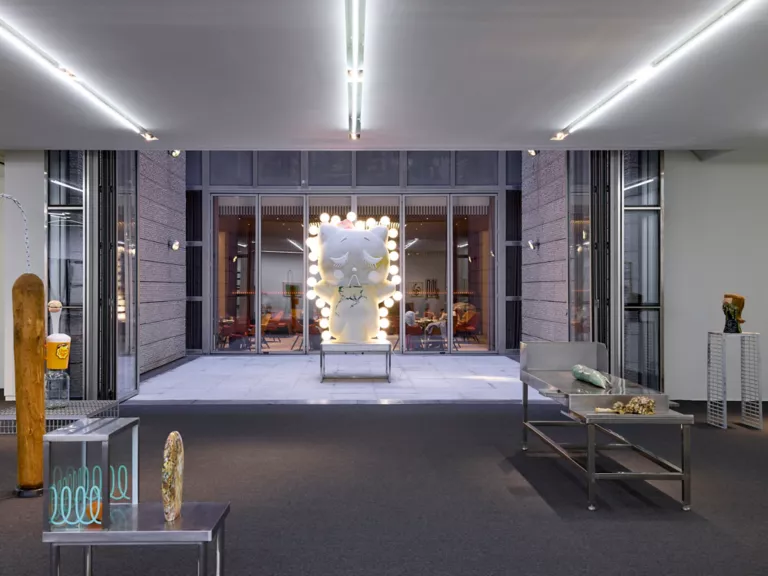 Poster image of Hwayeon Nam's solo exhibition "GABRIEL," Atelier Hermès, Seoul, 2022. © Fondation d'entreprise Hermès.
Poster image of Hwayeon Nam's solo exhibition "GABRIEL," Atelier Hermès, Seoul, 2022. © Fondation d'entreprise Hermès.Artist Hwayeon Nam’s solo exhibition GABRIEL is held at Atelier Hermès in Gangnam, Seoul, until January 29, 2023. The exhibition features four new video and installation works by Nam who participated in the main exhibition of the 2015 Venice Biennale and was the representative artist of the Korean Pavilion at the 2019 Venice Biennale.
Nam explores the relationship between movement and time. She uses the traces left by certain events or phenomena over time and her own imagination to reconstruct them into works. In her previous works, Nam visualized time through movement; in this exhibition, she collects still images to convey fragmented time.
In GABRIEL, Nam focuses on omens, signs, and forebodings and describes these abstract feelings and phenomena inspired by Gabriel, one of the three Roman Catholic archangels alongside Michael and Raphael. The archangel Gabriel is a messenger who foretells future events, particularly war and birth. The Annunciation—the announcement to the Virgin Mary that she would conceive a son by the power of the Holy Spirit, who would be named Jesus—is one of the key stories of Gabriel. This story is not described in Nam’s works; rather, it is used “more like a set of images and sounds that notify and foretell events to come that are unknown in reality.”
 Partial exhibition view of Hwayeon Nam's solo exhibition "GABRIEL" at Atelier Hermès, Seoul, 2022. Photo by Aproject Company.
Partial exhibition view of Hwayeon Nam's solo exhibition "GABRIEL" at Atelier Hermès, Seoul, 2022. Photo by Aproject Company.When you enter the dimly lit exhibition space, the unusually long wind instruments are the first thing you notice. Behind them is a black curtain that is visible through the light coming from a screen. The sound of the wind, as if it were cutting through the desert, and the sound of metal colliding create a feeling that is both lonely and strange.
For the metal pipe instrument work entitled Coda, the artist dismantled the wind instrument and reassembled it into a long form, adding sound. Coda is the Italian word for “tail,” as well as a musical element that brings a piece to an end. It instructs the player to repeat from the beginning to the indicated place and then play the tail part while repeating, changing, or expanding.
The work Coda comes with the sound of wind blowing at an unknown beat, the sound of wind instruments, and the sound of metal pipes. And this combination of sounds varies depending on the distance from the audience. Through these diverse sounds, the artist imagines the movement of time as a vortex. Coda is the first and last group of artworks that visitors see in the exhibition. In the same way that the coda in music brings a musical composition to a close, it brings the exhibition to an end.
 Partial installation view of 'Coda,' Hwayeon Nam's solo exhibition "GABRIEL" at Atelier Hermès, Seoul, 2022. Photo by Aproject Company.
Partial installation view of 'Coda,' Hwayeon Nam's solo exhibition "GABRIEL" at Atelier Hermès, Seoul, 2022. Photo by Aproject Company.Behind the black curtain is a 20-minute video work with sound installations. This work, which has the same title as the exhibition, consists of a large screen displaying images and video footage, as well as metal pillars with wind-sounding speakers.
The video and sound piece in GABRIEL lacks a narrative; it expresses the shock and wonder of being foretold of an unknown future, and the constant sound of the wind raises a sense of awe. The seemingly unrelated scenes and images in the video include paintings by artists such as Botticelli, Robert Campin, and Leonardo da Vinci, images taken by Mars Exploration Rovers, and images of stadium pillars.
 Partial exhibition view of Hwayeon Nam's solo exhibition "GABRIEL" at Atelier Hermès, Seoul, 2022. Photo by Aproject Company.
Partial exhibition view of Hwayeon Nam's solo exhibition "GABRIEL" at Atelier Hermès, Seoul, 2022. Photo by Aproject Company.Some of the images were derived from Annunciation scenes imagined by old masters. It contains a lily symbolizing the Virgin Mary’s purity, a ray of light emanating from the Holy Spirit, angel wings, and candle smoke. The image of Mars captured by the exploration rover “Perseverance” was included to imply an unknown time and space.
Behind the screen is a work titled New Temple (2022). On a white cloth, small clay sculptures are arranged to resemble the excavation site of an artifact. The artist created this work after learning that the traces of the vanished Maya civilization had been discovered in the Guatemalan jungle using lidar, a 3D laser scanning technology that enables remote mapping of atmospheric contents. To the artist, the process of discovering the nearly lost history with no surviving records using cutting-edge technology was similar to Gabriel’s Annunciation.
 Partial exhibition view of Hwayeon Nam's solo exhibition "GABRIEL" at Atelier Hermès, Seoul, 2022. Photo by Aproject Company.
Partial exhibition view of Hwayeon Nam's solo exhibition "GABRIEL" at Atelier Hermès, Seoul, 2022. Photo by Aproject Company.The work, Window-Dream (2022), is a group of drawings evoking the appearance of a corroded cupronickel plate. Windows, in paintings of the Annunciation, represent the passageway that connects humans and heaven. According to the artist, this window is the screen of today’s electronic devices, which connect us to the virtual world of infinite possibilities known as the internet.
Hwayeon Nam (b. 1979) held solo exhibitions at the Arko Art Center (Seoul, 2015) and Kunsthal Aarhus (Aarhus, 2019). Nam is especially known for her ten-year project that began in 2012, which was based on her research on a leading Korean modern dancer, Choi Seung-hee (1911–1969), who choreographed concerns about her identity as a Korean dancer during the Japanese colonial period but had few records left after defecting to North Korea. Nam’s works related to this project were shown and performed at various institutions around the world, including Festival Bom (Seoul, 2012), the 58th Venice Biennale Korean Pavilion (Venice, 2019), the Art Sonje Center (Seoul, 2020), and the “Performance/Documentation/Presentation” at Lund Museum (Lund, 2020).
















